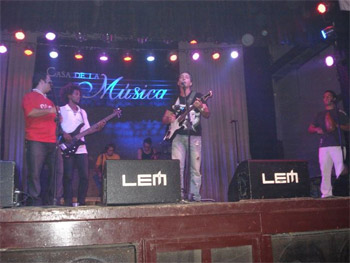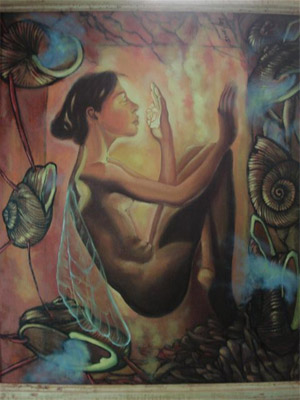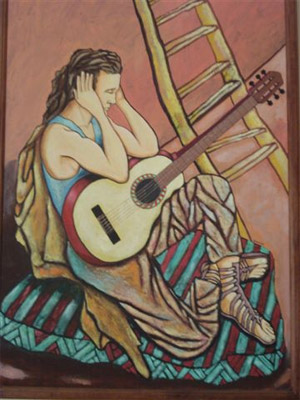Izael Carrazana, Troubadour and Painter
By Helson Hernandez

HAVANA TIMES, Nov. 6 — Troubadour and painter Izael Carrazana has brought together his creative endeavors in both the visual arts and music. As Izael commented, “Recording has been less accessible to young singers on the island.”
HT: What came first in your life, trova or painting?
Izael Carrazana: I must say that as a child I always liked drawing, and I also liked music, but at that time I was intrigued most with shapes, lines and colors.
HT: Specifically as a troubadour, what have been the artistic assumptions that have defined you?
IC: The richness of being oneself. A troubadour is a chronicler of their own time. There are examples that made me dream I’d find this possible, people such as Silvio, Pablo, Fernando Aramis (a troubadour from Bayamo), Sabina, Serrat, Vicente and Santiago Feliu, and all the singers who left us their legacy and marked our culture as something genuine.

HT: The Centro Cultural Pablo de la Torriente Brau is an institution that has helped young singers to find spaces for their work. Have you also benefited from this institution?
IC: I’ve been among those young singers who found a space for their work at the Centro Pablo, an institution of great value that has preserved this musical current. I appreciate being part of its cultural legacy, either on CDs or in some publication by the center, which in some way turns into reality what were initially pipe dreams. I’d like to express my thanks to Victor Cassaus, Maria Santucho and all people who work there.
HT: You’ve won several awards in music, tell us about these.
IC: When I was beginning as a troubadour, I participated in provincial festivals in Bayamo and I received several awards, which I think were due to my efforts to defend trova. This gave me the chance to record a documentary in which I included both my visual arts work and my musical work. This premiered in the National Telecentres Festivals.
I also recorded a music video of a song I wrote titled “Espejo de Otoño,” which won awards at these festivals. While in Havana in 2003, I participated in the Eduardo Saborit Campesina Music Competition and I won the grand prize, the UNEAC Award (from the National Union of Cuban Artists and Writers) and the award for orchestration. In 2006 the Centro Pablo de la Torriente Brau awarded me the Sindo Garay Creation Scholarship, a prize they offer to troubadours to further develop their work.

HT: Sincerely, where do you feel you’ve done more as an artist, in music or in the visual arts?
IC: I feel like I’ve done more in music, because I’ve put all my effort into achieving my goals. But I haven’t given up on the visual arts, it’s a part of me, every work is born from my spiritual needs.
HT: Your paintings show the insistence of the human figure. Does this have some sort of purpose for you?
IC: In my visual work the human figure is essential. Through it I attempt to convey feelings that people drag through life – the person who daydreams, disrupted by the spirit of improvement, the person who dances along an uncertain path but believes it possible.
HT: What have you found in each artistic expression, both in music and in painting?
IC: In painting I found free expression in everything that I can’t express in words or musical notes. The images are presented to me like that, as intermittent dreams, a big paradox in which the colors are endless sounds, flowing across a two dimensional space. And in the music I find another freedom expressed through sounds and words … words that also paint a picture and that make the listener or viewer imagine, feel and really believe in what I am.
HT: You were recently in Nicaragua. What commitments took you to that nation?

IC: Through my company, Empresa Musical Antonio Maria Romeo, I was selected for a cultural exchange with that sister nation of a revolutionary tradition. There, I was able to display my musical and visual work through presenting the project “Confesiones de un caminante,” which was well received. I performed in several cities, including Managua Esteli, Masalles, Matagalpa and San Juan del Sur, among others.
HT: Recording has been less accessible to young singers on the island. Do you have any comments about this?
IC: That’s true, the record labels haven’t been interested in the work of young troubadours of the island, except in rare cases. On the other hand we’ve been fortunate to have institutions such as the Centro Pablo where the concerts we troubadours have given have been produced and collected on CDs by the center itself. These have been at an acceptable level of quality and have helped legitimize the work of each creator.
For its part, the AHS (Asociacion Hermanos Saiz) has done a good job with troubadours through its program “Verdadero Complot.” Thanks to the new technologies, some singers have sought alternative labels that have allowed them to maintain their own aesthetics, and these have been largely successful for their growth and development, without having to brand the artistic creation with the approval from certain levels of bureaucracy.
We care about communicating these times, so to speak. More opportunities have appeared for troubadours, though I think we need to continue moving forward in that direction – making new roads, making creations, making history and not letting trova die. The song of today will be the truth guarded for all of the generation that believes in the power of poetry in their songs. The record companies are looking for worn out products that are repeated over and over again in different ways. They don´t look for what is truly authentic because that involves risks.
HT: What are you projections for the future?
IC: To keep making songs in my paintings and vice versa, to not lose my essence as an artist and to defend this road that always leads to a good place – one where there are no chairs inviting me to sit down.




